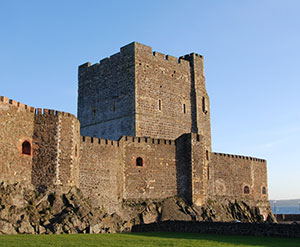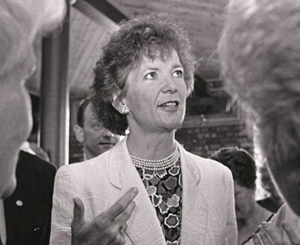February 04
Published in On this Day listing- 1992 President Mary Robinson became the first Irish president to visit Belfast.
- 1177

Above: Carrickfergus Castle, Co. Antrim—one of two John de Courcy strongholds still standing today. The other is Dundrum Castle, overlooking Murlough Bay, Co. Down.
John de Courcy and his legendary ‘twenty-two mailed horsemen’, fellow knights in Henry II’s Dublin garrison, set out to invade Ulster. With guides and c. 200 foot-soldiers from the native Irish, he passed through Meath, proceeded through the Moyry Pass into Ulster and turned east. Four days later he reached his target—the settlement of Down (Downpatrick), capital of the kingdom of Dál Fiatach, ruled by Rory MacDonleavy. One can only wonder what MacDonleavy’s sentries made of the approaching invaders, the storm troopers of medieval Europe, warriors covered in armour from head to toe, seated in deep saddles with kite-shaped shields and lances under arm. In any event, MacDonleavy and his subjects promptly fled but returned a week later with a great host to meet de Courcy on a slope adjoining the River Quoile. What followed was a massacre. De Courcy, described by the Norman chronicler Gerald of Wales as ‘a born fighter, always in the front line, always taking upon himself the greater share of the danger’, was in the thick of the action, ‘wielding his sword with deadly accuracy, lopping off the heads, arms and hands of his adversaries’. By nightfall the Irish had been pushed back to the mudflats of the Quoile, where many sank, ‘the blood pouring from their wounds coming up to the knees and legs of their pursuers’. A few months later an even greater Ulster coalition failed to banish him. De Courcy was to rule most of modern east Down and east Antrim for a quarter of a century. His two principal castles still stand today—Dundrum Castle, overlooking Murlough Bay, Co. Down, and the magnificent Carrickfergus Castle.
- 1868 Constance Markievicz, née Gore Booth, revolutionary and Sinn Féin politician, born in London.
- 1993 President Mary Robinson made her first visit to Northern Ireland. Her two-day private visit provoked a diplomatic rift between London and Dublin. Prime Minister John Major and Northern Secretary Sir Patrick Mayhew told Taoiseach Albert Reynolds that they regarded it as ‘unhelpful’ to the efforts being made to persuade the two unionist parties to rejoin talks on the political future of Northern Ireland. Reynolds held firm, however, telling Major that he was not going to pressurise the president in any way. In the event, unionists found cause for outrage. At a reception for local community leaders in West Belfast, during which she was introduced to and briefly greeted, as she recalled, ‘every person in the room’, it emerged that amongst them was Sinn Féin’s Gerry Adams, at the time working secretly with John Hume to find a peace formula. ‘Disgraceful behaviour’, declared DUP deputy leader Peter Robinson, calling on the British government to submit a protest to Dublin. Meanwhile the violence continued. At 1.15pm that day an off-duty RUC officer entered Sinn Féin party offices on the nearby Falls Road, shot dead three civilians and later took his own life. It transpired that he had originally been assigned to protection duties for President Robinson. That night she met members of the Belfast Solicitors’ Association at a dinner in Queen’s University, and the following morning attended another function in Coalisland, Co. Tyrone. Returning home, she would have heard of yet another atrocity just a mile from Queen’s: in the early afternoon, two UVF gunmen entered a bookmaker’s shop and killed five Catholics, including a fifteen-year-old schoolboy. More than 200 more lives would be lost before the signing of the Good Friday/Belfast Agreement.

















